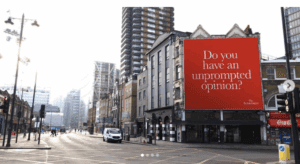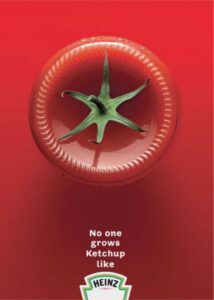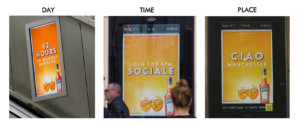There’s a curious trend sweeping adland: hiding or cropping the logo of your brand. We had the Heinz no-logo campaign that played with their “It has to be Heinz” slogan (below left) whilst still showing a product shot. We had British Airways (BA) cropping their logo in posters of people looking out of plane windows (below right).
But things went to a whole new level last week with the latest BA campaign featuring …. an engine*. My comment on a Linked In post about this campaign was viewed by over 60,000 people, suggesting this is a hot topic.
In this post, we look at the theory behind this approach. We then evaluate the BA campaign using our REAL BRAnD framework = Get REAL, Branded, Relevant and Amplified Distinctively.
*Look closer to see a reflection of the word “British” in reverse

CONTEXT: THE THEORY
To understand the theory behind this no-logo approach, let’s look at the Linked In post that brought the BA ad to my attention. It’s by the CMO of research company System 1. “My first thought was “wow that’s stunning”. My second was “dude where’s the logo?”. And then I saw it. In plane sight. And that’s what I like about this campaign. Sometimes doing a little work pays off. The beauty of the shot draws you in. The emotion of that moment just before you land. The intrigue of not immediately spotting the brand. The reward of seeing it in the reflection. The conversations it starts.”
To summarise, the idea is that 1. viewers of the poster will be intrigued, 2. they will stop to work out what’s missing, 3. they will solve the puzzle, 4. as a result they’ll feel rewarded, 5. this will make them more positive about the brand, 6. they will tell other people about the ad
You can probably guess that I have a different view about BA’s engine ad…
1. GET REAL
In real life we react to marketing using “system 1” thinking, which is immediate and intuitive. Real people will see the BA poster for only a couple of seconds. Not only that, in the real world they will be driving a car, walking in the street or riding a bike.
Ironically, the Linked In post from agency System 1, along with most of the comments, used analytical “system 2” thinking to positively praise the BA ad!
When you spend your life immersed in branding, it’s easy to imagine everyone will get the in-joke. “Choosing to hide the logo and lead with emotion transforms the audience from passive viewers into active participants. It’s rare to see this level of trust in the audience today,” said one Linked In comment.
However, most real people in real life don’t spend their days decoding ads. How many people really want to be transformed from a passive viewer into an active participant? “It feels more like work made to impress the industry than something that connects with people in a meaningful way,” suggested one reply to my comment.
2. TELL CHAPTERS of YOUR BRAND STORY
Great marketing campaigns tell a chapter of your brand story. In this way, they create “fresh consistency”, by giving a fresh expression of your brand positioning.
With the BA engine ad, I struggle to see how this is saying something positive about the brand’s story. How does a picture of the engine of a BA plane create any positive memory structure for BA?
Now, other people did have a different view here. “That’s the beauty of it. Where you see an engine I see a point of view,” said one reply to my comment. “As a viewer I think it’s fresh and doesn’t feel like BA is trying hard to sell me something, yet somehow it makes the brand feel more appealing.” The idea is, I guess, that this evokes positive associations about landing somewhere tropical in a BA plane. Or landing home in London. But even then, the ad sells travel but says nothing about why to chose BA specially.
A more effective approach in my book is to be much clearer in the brand story you tell. Contrast the BA engine ad with the Economist’s long running and award winning outdoor campaign, which also asks the viewer to do some work. Each execution clearly and impactfully tells a chapter of the brand story about being a tool to help people be smarter and have an opinion. I love this recent execution about the role The Economist can still play in an age of AI.

3. BE RELEVANT AND “AVOID BRAND EGO TRIPS”
At its best, advertising tells a story that connects a product truth with a consumer need, to deliver a relevant benefit. Take the Heinz ketchup campaign below. This builds on a product truth that Heinz grow their own tomatoes. This is part of what creates the distinctive Heinz taste. This ad is highly relevant. It talks to the need for reassurance on naturalness and a desire for great taste. it also does a brilliant job of amplifying the brands distinctive assets.
In contrast, BA’s hidden-logo ad feel like a “brand ego trip”. The brand is saying “We’re so famous, you’ll want to play spot-the-logo with us!” But fame without a functional benefit feels fad-like.


4. AMPLIFY DISTINCTIVELY
Hiding your logo in the hope people will find it seems like a massive missed opportunity. Maybe if you have a huge budget, you can afford to play Hide the Logo. “Nike can hide the Swoosh. Apple can hide the Apple. British Airways can hide in a moment,” suggested the Linked In post. But even then, why do this?
Is a better route not to amplify your distinctive brand assets: logo, colours, shapes, pack design? These are the shortcuts that help people instantly connect the ad to your brand. It makes business sense. And it also makes life easier for consumers in a world of information overload. The smart poster campaign from Aperol below is an example of applying distinctive brand assets, as I posted on here. The orange colour of Aperol plays a central role in all the brand’s communication, along with the blue logo and the bottle. The outdoor campaign harnessed digital technology and smart media planning to target specific days, times and locations (see below).

CONCLUSION
To paraphrase my comment on the Linked In post, it feels like the marketing and advertising community is talking to itself and seeing who can win the “Hide the Logo” game. In the couple of seconds real people (on a bus, in a car, on a bike) look at the BA poster, I expect most will, like me, see just an engine.
However, I’m ready to change views if someone, maybe System 1, can get some actual data on what (if anything) the campaign does for BA’s brand and business!
